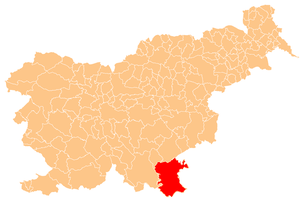White Carniola

White Carniola (Slovene: Bela krajina; Croatian: Bela krajina; German: Weißkrain or Weiße Mark) is a traditional region in southeastern Slovenia on the border with Croatia. Due to its smallness, it is often considered a subunit of the broader Lower Carniola region, although with distinctive cultural, linguistic, and historical features.[1]
Due to its proximity with
Geography

The area is confined by the
The region corresponds to the present-day municipalities of Metlika, Črnomelj and Semič. The terrain is characterised by low karst hills and extensive birch forests. The main river is the Kolpa with its Lahinja, Dobličica and Krupa tributaries.
White Carniola is known for Grič and Kanižarica pottery from clay with a distinct calcite content, as well as for high-quality wines, such as metliška črnina (a dark red wine), belokranjec (a white wine), and modra frankinja (i.e. Blaufränkisch).
Tradition

A distinguishing part of White Carniola is its folk heritage. It still has many folklore events, which show traditional local costumes, music, played on a regionally known instrument called
Name
The name Bela krajina literally means 'White March'. The noun
History
Middle Ages
In the early 12th century, the area was part of the disputed border region between the
The Counts of Weichselberg, who traced their lineage to Saint
Early modern period
With the Ottoman conquest of the Balkans, groups of Serbs and Croats fled to the north or west; of the western migrational groups, some settled in White Carniola and
In his 1689 work The Glory of the Duchy of Carniola, the historian Johann Weikhard von Valvasor described the language, clothing, and customs of the people of White Carniola region as Croatian. The self-identification of students on the university registers in Graz and Vienna between 1643 and 1712 shows that as many as 88% of students from White Carniola identified as Croats, and only 12% as Carniolans. The provincial designation 'Croats' (Crovathen/Crobathen) was used for White Carniola in 1709, and the name 'Croats' for the inhabitants of White Carniola is found in 1725 in a report by a doctor named Zalokar from Novo Mesto. The dialect of the parish of Vinica in far southern White Carniola was marked as Croatian in 1795.[18]
Buildings
Castles

Several castles were built in the border region, especially during the
.Culture
Based on surnames found in White Carniola, it may be concluded that their ancestors were Serbs and Croats.[19] In old folk poetry of White Carniola, Serbian hero Prince Marko is often mentioned, sung in "clean Shtokavian".[19] A small Serb community exists in White Carniola.[20]
Notable people
Notable people that were born or lived in White Carniola include:
- Juro Adlešič (1884–1968), lawyer and politician, mayor of Ljubljana from 1935 to 1942
- Draga Ahačič (1924–2022), actress, film director, translator, and journalist
- Andrej Bajuk (1943–2011), politician and economist
- Joe Cerne (born 1942), American football player
- Oton Gliha (1914–1999), Croatian painter
- Miran Jarc (1900–1942), writer, poet, playwright, and essayist
- Lojze Krakar (1926–1995), poet, translator, editor, literary historian, and essayist
- Radko Polič (1942–2022), actor
- Bishop of Lead, South Dakota, serving from 1902 to 1909
- John Vertin (1844–1899), Catholic priest, Bishop of Marquette in the US state of Michigan from 1879 to 1899
- Oton Župančič (1878–1949), poet, playwright, and translator
References
- ^ Ferenc, Tone (1988). "Dolenjska". Enciklopedija Slovenije. Vol. 2. Ljubljana: Mladinska knjiga. p. 287.
- ^ "Bela Krajina". Retrieved 26 August 2016.
- ^ a b c d e Snoj, Marko (2009). Etimološki slovar slovenskih zemljepisnih imen. Ljubljana: Modrijan. pp. 55, 101.
- ^ Lah, Iva. 1928. "Župančičeva mladina." In: Albrecht, Fran (ed.) Jubilejni zbornik za petdesetletnico Otona Župančiča (pp. 85–90). Ljubljana: Tiskovna zadruga, p. 86.
- ^ Longley, Norm. 2007. The Rough Guide to Slovenia. London: Rough Guides, p. 233.
- ^ Copeland, Fanny S. 1931. "Slovene Folklore" Folklore: A Quarterly Review of Myth, Tradition, Institution & Custom 42(4): 405–446, p. 431.
- ^ a b Koštiál, Ivan. 1930. "Jezikovne drobtine." Ljubljanski zvon 50(3): 179–180, p. 180.
- ^ Reichenbach, Anton Benedict. 1848. Neueste Volks-Naturgeschichte des Thierreichs für Schule und Haus. Leipzig: Slawische Buchhandlung, p. 58.
- ^ Wessely, Josef. 1853. Die oesterreichischen Alpenlaender und ihre Forste. Vienna: Braumüller, p. 2.
- ^ Büsching, Anton Friedrich. 1762. A New System of Geography. Vol. 4. Trans. P. Murdoch. London: A. Millar, p. 214.
- ^ Smollett, Tobias George. 1769. The Present State of All Nations. London: Baldwin, p. 244.
- ^ Moodie, Arthur Edward. 1945. The Italo-Yugoslav Boundary: A Study in Political Geography. London: G. Philip & Son, p. 32.
- ^ Glasnik Etnografskog instituta. Vol. 52. Научно дело. 2004. p. 189.
- ^ Drago Perko, Rok Ciglič, Matija Zorn, The Geography of Slovenia: Small But Diverse, 2019, https://www.bookdepository.com/Geography-Slovenia-Drago-Perko/9783030140656 #page=150
- ISBN 978-3-643-50235-3.
- ISBN 0631204717
- ^ a b Akademija nauka i umjetnosti Bosne i Hercegovine. Odjeljenje društvenih nauka (1970). Radovi odjeljenje društvenih nauka. Vol. 12. p. 158.
- ^ Golec, Boris (2017). "Širenje hrvatskog etnonima i lingvonima na slovensko stanovništvo današnje istočne Slovenije između 16. i početka 19. stoljeća i njihovo iščeznuće". Radovi: Radovi Zavoda za hrvatsku povijest Filozofskoga fakulteta Sveučilišta u Zagrebu. 49 (1): 131–132. Retrieved October 29, 2019.
- ^ a b Prosvjeta: mjesečnik Srpskog kulturnog društva Prosvjeta. Društvo. 1969. pp. 8–10.
- ^ Subašić, B. (2014-01-29). "Belu Krajinu nema ko da čuva" (in Serbian). Novosti.
